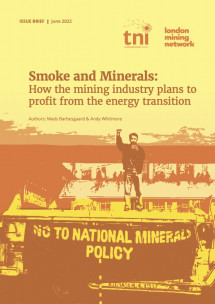Smoke and Minerals How the mining industry plans to profit from the energy transition
While most of us probably rarely think about it on a daily basis, the handful of transnational corporations that dominate the mining industry play a key role in providing inputs for goods we use every day – from smartphones to food. Their profits stem from their role in the production of these goods: control of extraction of minerals at the starting point of the vast global supply chains that stretch from Chilean and Congolese mineral landscapes to – in the case of smartphones – our pockets.

Descargas
Autores
The International Energy Agency has argued that for the energy transition to take place a massive “scaling up [of] investment in new mining and processing facilities is vital”. This particularly concerns the so-called ‘transition minerals’, e.g. copper, nickel, manganese, lithium, cobalt and rare earth elements, all of which are expected to be facing supply gaps due to their importance for the production and expansion of non-fossil fuel technologies – from wind turbines to the batteries in electric vehicles.
For the mining companies that can extract and supply these minerals, this future outlook promises huge prospective profits and consequently, they are currently strategizing as to how to benefit from the rise in demand. But what do these strategies look like and what challenges do they raise for those engaged in struggles with/against mining capital?




